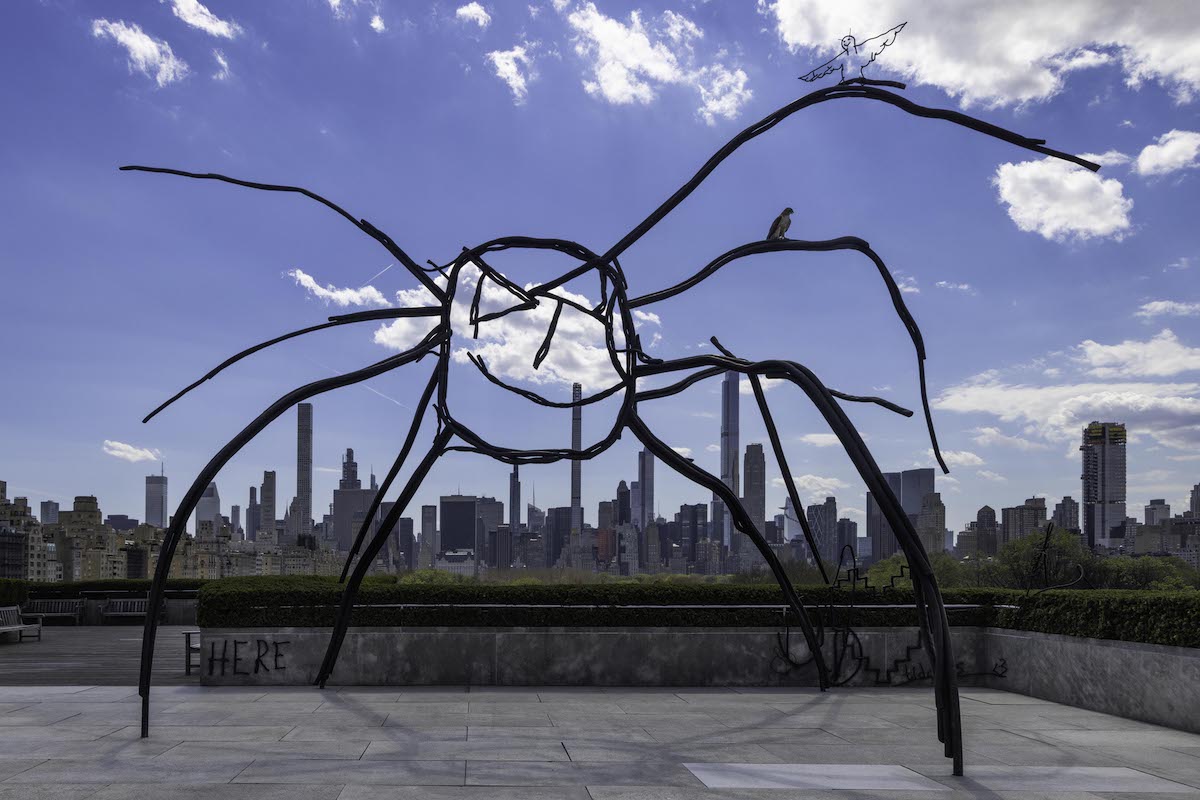

A giant spider currently looms over the Metropolitan Museum of Art’s rooftop, its face crumpled into a knowing smile. The arachnid would seem terrifying if it didn’t also play host to a friendly companion: a tiny bird perched atop one crooked leg, wings outstretched as though it were about to take flight.
Together, the two form quite the duo. But depending on where you stand, they may both melt away into the skyline behind them, rendering them just another bizarre footnote in the vast New York ecosystem. Amid a downpour, the grinning spider may not be visible at all.
Petrit Halilaj, a 38-year-old phenom from Kosovo, is the maker of these sculpted animals, which are part of his rooftop commission for the Met. The museum has now done nearly a dozen of these commissions, each created by a different artist every summer. Most have been big, extravagant, and tacky. Halilaj’s, by contrast, is pared-down and minimal, and is the best of the bunch because of it.
The artist is no stranger to grand sculptures, having made a name for himself at the 2010 Berlin Biennale by showing a to-scale facsimile of the armature for his family’s Prishtina home. He’s even made another house-like structure for the Met’s roof, peopling it with a stick figure and a golden star. You can walk under the structure and peer up at a Picassoid eye that stares back down.
That’s the closest that Halilaj’s latest, an installation called Abetare (2024), gets to Instagram fodder. Setting aside the house and the spider, much of the steel components are spare, modestly scaled, and semiabstract.
Many feature words welded together that provide insight into Halilaj’s reference points. Some of the words are telling. The name Runik, Halilaj’s hometown, appears in one work. The acronym KFOR, short for the Kosovo Force, shows up in another. These act as reminders that Abetare, which refers to books used to teach Kosovar children the alphabet, is embedded within Halilaj’s own experience as a Kosovar whose life was disrupted by the Yugoslav Wars of the 1990s.

Amid war in Kosovo, Halilaj was displaced to a refugee camp in Albania as a teenager. There, he was encouraged to draw by a group of Italian psychologists who visited the site. For Halilaj, art became both a creative outlet and a means of self-preservation: drawing mountainous landscapes and soldiers holding guns was a way to process his tumultuous situation. He’s consistently returned to those sketches as an adult, at times enlarging them to form new artworks.
But Halilaj’s drawings aren’t the only ones that feature in his beguiling sculptures, which have more recently tended to feature ones he found in Kosovo schoolrooms. Here, he’s expanded his inquiry beyond his home country, focusing on other Balkan nations as well.
The spider, for instance, was sourced from a banged-up desk in Skopje, North Macedonia, where it was initially accompanied by references to Pokémon that are now absent. Another sculpture pairs a heart-shaped form beside a phallus and the word “tiddies.” Rather than simply repeating the found imagery, however, he mixes them, implying a form of solidarity among teens—innocent and horny alike—separated by national borders.
By appropriating kids’ marks, Halilaj warmly suggests that these doodles are artistic endeavors worth noting. It’s not possible to retrieve any information about who these budding artists were, however; their names have been lost. Abetare is infused with the sense that nothing lasts forever, hence the frail look of these steel creations.
But that apparent fragility may be misleading. Halilaj said that the Met required that his work be able to withstand a hurricane. In addition to fulfilling a contract, Halilaj has rendered these children’s drawings monumental, and ensured that they resist the test of time—and, apparently, climate change.

Even if Abetare presents a weighty commentary on the tenuousness of national histories, Halilaj has wisely offered moments of levity. Be sure to spot the cat person dangling from a flower-strewn pergola on your way out, and don’t forget the toothy kitty leaned against the area next to a bench.
Take a second, too, to muse before a louvered screen set within a low wall. Next to it, Halilaj has placed an evocative word: HERE. It could refer to a city (New York), a museum (the Met), or a particular part of an institution (its ventilation system). Technically, this HERE is from elsewhere (the Balkans), but it looks quite at home in its funky new locale.